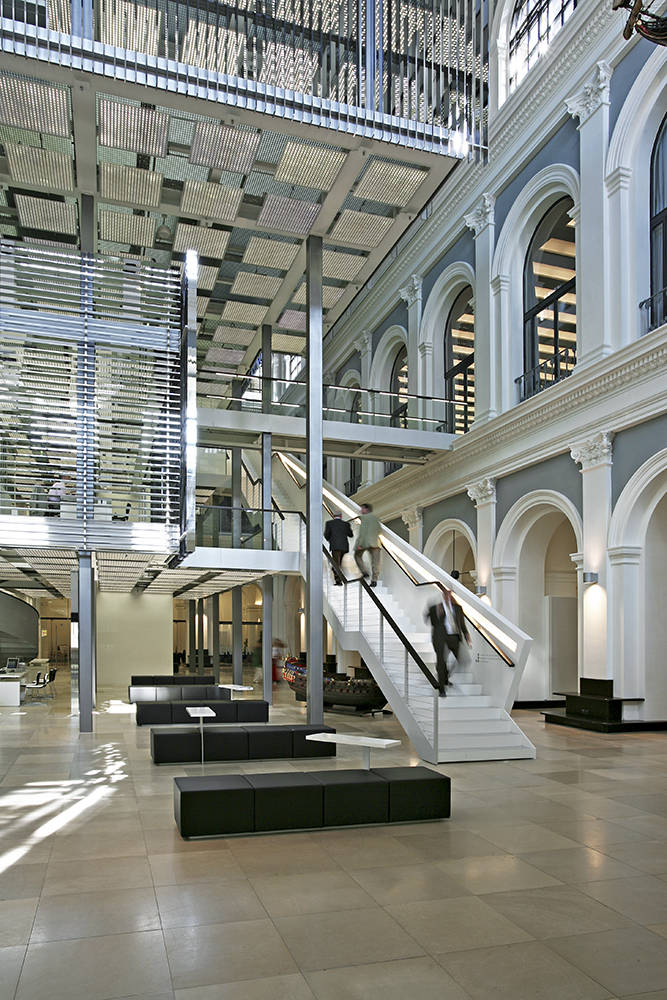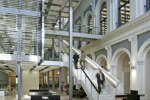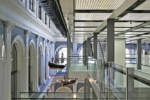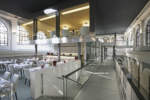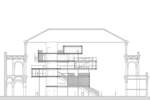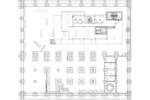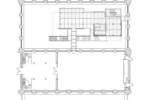architect: Behnisch Architekten
location: Hamburg
For a good 340 years, the Hamburg Chamber of Commerce (Handelskammer) has been not only the central stock exchange and hub of the city‘s economic life, but also a place of great social importance.
Situated close to major city landmarks, the Binnenalster and the Jungfernstieg, this building and the City Hall together comprise the oldest classical architectural ensemble to have survived in the city. The Chamber of Commerce is an institution: a critical political lobbyist, a provider of comprehensive services to the business community and an independent advocate of the trade. In order that it might continue to fulfil these diverse functions in future years, it became necessary to radically convert the interior of the building on Adolphsplatz.
The Chamber of Commerce had initially envisaged only a 3-storey inner extension of the original structure, yet the dimensions of this would have covered the hall‘s entire ground floor surface area. The architectural practice Behnisch & Partner (Günter Behnisch and Manfred Sabatke) concluded in the course of the architectural design competition launched in 2003 that such a broad 3-storey structure would considerably detract from the hall‘s overall appearance. They therefore proposed a 5-storey structure with a much smaller footprint, which would instead exploit the hall‘s height. The winning proposal‘s core concept was to create a predominantly transparent structure with a large surface area. In the course of elaborating the design it became evident, however, that various technical requirements would hamper its realisation. The original building rests on oak piles and this necessitated a number of security measures, including more comprehensive fire prevention.
The client furthermore wished that ‘business as usual‘ continue unimpeded throughout the construction phase, which meant that numerous elements would have to be prefabricated and discreetly delivered to the site in manageable dimensions.
Transparency could consequently have been attained only in certain parts of the structure. Only by further revising the concept was it possible to achieve the desired impression of lightness.
The structure unfolds as seemingly free-floating levels and planes that consciously contrast the historic hall‘s ponderous stone bulk: here, the soft lines of vaulted constructions, there, the clear lines of the new structure: a bright apparition constructed of luminous, transparent and reflective materials, reminiscent of a glittering, multi-faceted jewel that absorbs and refracts light.
To all appearances and despite the evidently shared space, common features are consciously lacking. On the one hand, the site‘s interior arrangement fulfils each respective area‘s practical requirements yet, on the other, it is conceived in such a way as to give rise within itself and in its relation to the historical building to a shifting spectrum of spatial situations that surprise and fascinate visitors. The new extension thus functions as a prism through which the historic hall can be perceived from various perspectives in unendingly new variations.
The new development provides space for a Business Start-up and Development Unit, the display of the Chamber‘s Library of Commerce – the oldest of its kind in the world – and a Club with premium catering.
Opposite the original Service Centre on the ground floor is an Information and Advice Centre run by the Business Start-up and Development Unit, which has further counselling areas and three enclosed spaces for confidential talks directly above, on the first level, reached by spiral stairs.
The second level is linked by a bridge with the ‘Albert Schäfer Auditorium‘ in the historical hall and can hence provide additional space for receptions, exhibition openings and other events. Busts of renowned citizens of Hamburg flank this level, which a further bridge links to the reception area of the historical hall‘s ‘Praeses suite‘: the offices of the Chairman of the Board.
The third level accommodates the Chamber of Commerce‘s exhibition, ‘We Act for Hamburg‘ and a further area reserved for the display of bibliographic treasures from its Library of Commerce, which are duly protected in specially designed showcases. The two upper levels have a more private character and are accessed by smaller, internal stairs. On Level 4 is the Börsen Club restaurant. Visitors can enjoy a panoramic view of the hall from its extensive terrace.
From the bar adjoining the restaurant, one can follow a series of showcases containing further exhibits from the Commerzbank Collection to reach the lounge and cabinets on the fifth level.


